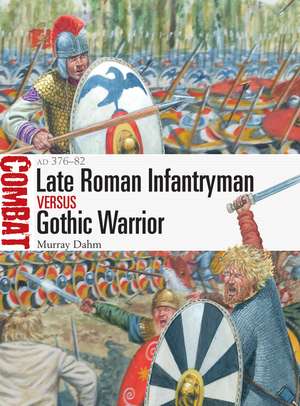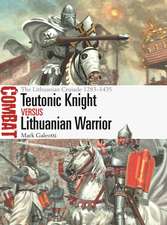Late Roman Infantryman vs Gothic Warrior: AD 376–82: Combat, cartea 56
Autor Dr Murray Dahm Ilustrat de Giuseppe Ravaen Limba Engleză Paperback – 23 iun 2021
Din seria Combat
- 25%
 Preț: 75.88 lei
Preț: 75.88 lei - 24%
 Preț: 71.99 lei
Preț: 71.99 lei - 24%
 Preț: 76.58 lei
Preț: 76.58 lei - 25%
 Preț: 71.01 lei
Preț: 71.01 lei - 38%
 Preț: 66.79 lei
Preț: 66.79 lei - 25%
 Preț: 75.42 lei
Preț: 75.42 lei - 24%
 Preț: 71.46 lei
Preț: 71.46 lei - 25%
 Preț: 66.60 lei
Preț: 66.60 lei - 24%
 Preț: 62.18 lei
Preț: 62.18 lei - 25%
 Preț: 71.20 lei
Preț: 71.20 lei - 25%
 Preț: 75.00 lei
Preț: 75.00 lei - 25%
 Preț: 75.00 lei
Preț: 75.00 lei - 24%
 Preț: 71.46 lei
Preț: 71.46 lei - 25%
 Preț: 70.58 lei
Preț: 70.58 lei - 24%
 Preț: 63.16 lei
Preț: 63.16 lei - 25%
 Preț: 61.76 lei
Preț: 61.76 lei - 42%
 Preț: 62.18 lei
Preț: 62.18 lei - 34%
 Preț: 66.79 lei
Preț: 66.79 lei - 25%
 Preț: 66.17 lei
Preț: 66.17 lei - 38%
 Preț: 66.60 lei
Preț: 66.60 lei - 38%
 Preț: 66.60 lei
Preț: 66.60 lei - 24%
 Preț: 67.96 lei
Preț: 67.96 lei - 25%
 Preț: 75.80 lei
Preț: 75.80 lei - 24%
 Preț: 67.49 lei
Preț: 67.49 lei - 24%
 Preț: 67.05 lei
Preț: 67.05 lei - 24%
 Preț: 67.05 lei
Preț: 67.05 lei - 34%
 Preț: 66.92 lei
Preț: 66.92 lei - 24%
 Preț: 67.05 lei
Preț: 67.05 lei - 25%
 Preț: 66.60 lei
Preț: 66.60 lei - 24%
 Preț: 66.79 lei
Preț: 66.79 lei - 24%
 Preț: 66.79 lei
Preț: 66.79 lei - 38%
 Preț: 67.05 lei
Preț: 67.05 lei - 24%
 Preț: 67.05 lei
Preț: 67.05 lei - 24%
 Preț: 67.05 lei
Preț: 67.05 lei - 25%
 Preț: 71.17 lei
Preț: 71.17 lei - 25%
 Preț: 65.72 lei
Preț: 65.72 lei - 25%
 Preț: 71.27 lei
Preț: 71.27 lei - 25%
 Preț: 71.01 lei
Preț: 71.01 lei - 25%
 Preț: 71.20 lei
Preț: 71.20 lei - 25%
 Preț: 71.01 lei
Preț: 71.01 lei - 25%
 Preț: 71.11 lei
Preț: 71.11 lei - 25%
 Preț: 71.11 lei
Preț: 71.11 lei - 25%
 Preț: 71.20 lei
Preț: 71.20 lei - 26%
 Preț: 73.66 lei
Preț: 73.66 lei - 25%
 Preț: 75.61 lei
Preț: 75.61 lei - 25%
 Preț: 75.88 lei
Preț: 75.88 lei - 25%
 Preț: 75.00 lei
Preț: 75.00 lei - 25%
 Preț: 75.88 lei
Preț: 75.88 lei - 25%
 Preț: 75.88 lei
Preț: 75.88 lei
Preț: 66.79 lei
Preț vechi: 88.37 lei
-24% Nou
Puncte Express: 100
Preț estimativ în valută:
12.78€ • 13.32$ • 10.58£
12.78€ • 13.32$ • 10.58£
Carte disponibilă
Livrare economică 13-27 martie
Livrare express 27 februarie-05 martie pentru 42.23 lei
Preluare comenzi: 021 569.72.76
Specificații
ISBN-13: 9781472845283
ISBN-10: 1472845285
Pagini: 80
Dimensiuni: 184 x 248 x 9 mm
Greutate: 0.26 kg
Editura: Bloomsbury Publishing
Colecția Osprey Publishing
Seria Combat
Locul publicării:London, United Kingdom
ISBN-10: 1472845285
Pagini: 80
Dimensiuni: 184 x 248 x 9 mm
Greutate: 0.26 kg
Editura: Bloomsbury Publishing
Colecția Osprey Publishing
Seria Combat
Locul publicării:London, United Kingdom
Caracteristici
Late Roman subjects remain popular among Osprey readers, with recent titles including Catalaunian Fields AD 451, Milvian Bridge AD 312 and Strasbourg AD 357.
Notă biografică
Murray Dahm is a freelance historian and the author of Greek Hoplite vs Persian Warrior for Osprey. He has written more than 50 articles for magazines such as Ancient Warfare, Medieval Warfare and Ancient History. Murray lives in Australia.Giuseppe Rava was born in Faenza in 1963, and took an interest in all things military from an early age. Entirely self-taught, Giuseppe has established himself as a leading military history artist and is inspired by the works of the great military artists, such as Detaille, Meissonier, Röchling, Lady Butler, Ottenfeld and Angus McBride. He lives and works in Italy.
Cuprins
IntroductionThe Opposing SidesMarcianopolis, AD 376The Willows, AD 377Adrianople, 9 August AD 378AnalysisAftermathBibliographyIndex



